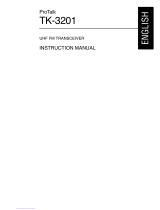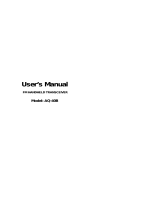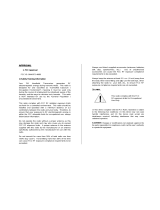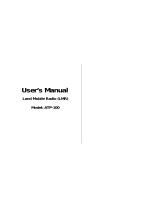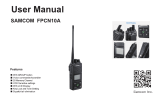Page is loading ...

© B62-1976-00 (K)
09 08 07 06 05 04 03 02 01 00
UHF FM TRANSCEIVER
TK-3230
INSTRUCTIoN MANUAl

Thank You
We are grateful for your purchase of this Kenwood product
and welcome you to the Business Radio Service (BRS). Your
Kenwood 2-way Business Radio is called a “transceiver”,
meaning “transmitter & receiver”. We believe this easy-to-use
transceiver will provide you with dependable and reliable
communications. This Kenwood transceiver is a precision
device. Treat it with care, and you will enjoy years of reliable
operation.
FeaTures
• Lightweight and compact design using a lithium-ion battery pack,
with a sturdy, polycarbonate body and a spring-loaded belt clip.
• 122 tone/code settings for each channel, allowing you to ignore
unwanted calls.
• Privacy Talk scrambles all your voice messages, giving you
complete privacy for your conversations.
• FleetSync operation, allowing a variety of call types.
• Automatic battery power saver, providing you with longer battery
usage.
• Battery power level indicator with low battery power warning.
• Key lock and Super Lock prevent you from accidentally changing
your transceiver settings.
• Ten different calling alert tones allows you to identify yourself to
your group before you begin speaking.
• Hands free operation when using an optional headset.
operaTing CondiTions
Open locations (no obstructions) Up to 4 miles (6.4 km)
Residential areas (near buildings) Up to 1.5 miles (2.4 km)
In steel/ concrete reinforced buildings
Up to 200,000 ft
2
(18,580 m
2
)
In high rises Up to 15 oors
Note: The listed ranges are based on eld testing and may vary
with your operating conditions.

i
FCC LICENSE INFORMATION
Your Kenwood radio operates on communications frequencies
which are subject to FCC (Federal Communications
Commission) Rules & Regulations. FCC Rules require that all
operators using Private Land Mobile radio frequencies obtain a
radio license before operating their equipment. Application for
license must be made on FCC form 601.
FAX: Forms can be obtained by fax from the FCC
Fax-On-Demand system. Call 1-202-418-0177 from your
fax machine to request the documents.
MAIL: Forms can be ordered by telephone, and will be sent to
1-800-418-FORM (1-800-418-3676).
INTERNET: Form 601 and instructions can be downloaded
from the FCC Forms website at:
http://www.fcc.gov/formpage.html
section, you must decide which frequency (or frequencies) you
will operate on. Refer to the frequency chart on page 44.
Questions? Call the FCC for license application questions at
1-888-CALL-FCC (1-888-225-5322).
CHANNEL SPACING
xls
spacing may not have optimal sound quality when used with

ii
NOTICES TO THE USER
subject to the following two conditions:
(1) this device may not cause harmful interference, and
(2) this device must accept any interference received, including
interference that may cause undesired operation.
One or more of the following statements may be applicable:
FCC WARNING
INFORMATION TO THE DIGITAL DEVICE USER REQUIRED BY THE FCC
limits are designed to provide reasonable protection against harmful
interference in a residential installation.
energy and, if not installed and used in accordance with the
instructions, may cause harmful interference to radio communications.
in a particular installation. If this equipment does cause harmful
interference to radio or television reception, which can be determined
by turning the equipment off and on, the user is encouraged to try to
correct the interference by one or more of the following measures:
• Reorient or relocate the receiving antenna.
• Increase the separation between the equipment and receiver.
• Connect the equipment to an outlet on a circuit different from that to
which the receiver is connected.
• Consult the dealer for technical assistance.

iii
SAFETY INFORMATION:
Your wireless hand-held portable transceiver has been designed using
a low power transmitter.
When the PTT switch is pressed, the transceiver generates radio
frequency (RF) electromagnetic energy (EME).
FCC 96-326 (August, 1996).
• Do not transmit for more than 50% of the total operating time.
the LED that lights red while transmitting.
2 inches (5 cm) from your head and body.
• When using a headset, ensure that the antenna is at least
2 inches (5 cm) away from your body whenever you are
transmitting.
• Use only Kenwood
violate FCC rules and regulations.
ATTENTION (U.S.A. Only):
Kenwood
Kenwood
program to collect and recycle Li-ion batteries
program is an alternative to disposing Li-ion
batteries with your regular refuse or in municipal
waste streams, which is illegal in some areas.
For information on Li-ion battery recycling in your area, call (toll free)
Kenwood
preserve our environment and conserve our natural resources.

iv
• Government law prohibits the operation of unlicensed radio
transmitters within the territories under government control.
Safety: It is important that the operator is aware of and
transceiver.
PRECAUTIONS
wet.
• Ensure that there are no metallic items located between the
Kenwood.
• If the die-cast chassis or other transceiver part is damaged, do
not touch the damaged part.
• If a headset or headphone is connected to the transceiver,
reduce the transceiver volume. Pay attention to the volume
level when turning the squelch off.
near machinery that may catch the cable.
• Do not place the transceiver on unstable surfaces.
• Ensure that the end of the antenna does not touch your eyes.
• When the transceiver is used for transmission for many hours,
the radiator and chassis will become hot. Do not touch these
• Do not immerse the transceiver in water.
• Always switch the transceiver power off when installing
optional accessories.

v
metallic powders, grain powders, etc.).
• Near explosives or blasting sites.
• In aircrafts. (Any use of the transceiver must follow the
instructions and regulations provided by the airline crew.)
• Where restrictions or warnings are posted regarding the use of
radio devices, including but not limited to medical facilities.
• Do not disassemble or modify the transceiver for any reason.
• Do not place the transceiver on or near airbag equipment while
• Do not transmit while touching the antenna terminal or if
any metallic parts are exposed from the antenna covering.
transceiver, switch the transceiver power off immediately, remove
Kenwood
dealer.
area.
• Do not expose the transceiver to extremely hot or cold conditions.
as they may short the battery terminals.
• When operating the transceiver in areas where the air is dry, it is
easy to build up an electric charge (static electricity). When using
an earphone accessory in such conditions, it is possible for the

vi
Contents
...........................1
supplied Accessories ............................................................1
...........................................................................2
displAy ..................................................................................3
..........................................................................4
BAttery pAck precAutions ....................................................4
instAlling/ removing the BAttery pAck ..................................9
chArging the BAttery pAck .................................................10
instAlling/ removing the Belt clip ...................................... 11
instAlling/ removing optionAl Accessories .........................12
................................................................13
............................................15
.......................................16
.................................................17
revert chAnnel ..................................................................18
.....................................................19
squelch level ....................................................................19
....................................20
vox operAtion ...................................................................20
vox gAin ...........................................................................20
vox delAy time ..................................................................21
vox trAnsmit inhiBit ..........................................................22
vox proceed tone ............................................................23
........................................................................24
...................................................................25
cAlling Alert ......................................................................26
selcAll (selective cAlling) ................................................28
........................................................33
speAker mute .....................................................................33
trAnsmission power ............................................................33
compAnder ..........................................................................34

vii
key lock .............................................................................34
super lock .........................................................................35
displAy BAcklight ................................................................35
microphone sensitivity .......................................................36
time-out timer ....................................................................37
BAttery sAve ......................................................................38
BAttery indicAtor ................................................................39
incoming cAll notificAtion type ..........................................40
Busy chAnnel lockout (Bcl) .............................................41
trAnsceiver Beep ................................................................41
mode reset time.................................................................42
..........................................43
....................................................44
....................................................................................45
........................................................47
.....................................................49
...................................................................50
.................................................51

1
UNPACKING AND CHECKING EQUIPMENT
Carefully unpack the transceiver. We recommend you identify
the items listed in the following table before discarding the
packing material. If any items are missing or have been
damaged during shipment, le a claim with the carrier
immediately.
Supplied AcceSSorieS
Item Part Number Quantity
Belt clip J29-0736-XX 1
Screw set N99-2063-XX 1
KNB-46L battery pack — 1
KSC-37 rapid charger — 1
Warrany card — 1
Instruction manual B62-1976-XX 1
Belt clip Screw set

2
ORIENTATION
/ keys
Press to change the operating
channel, to select a menu in
Setting Mode, and to perform
other functions.
Antenna
Power switch/
Volume control
Turn clockwise to
switch the power
ON and counter-
clockwise to
switch the power
OFF. Rotate to
adjust the volume.
MENU key
Press to perform various
functions. Press and
hold while switching the
power ON to enter
Setting Mode.
CAL key
Press before
making a call
to alert the
other party
members, or
press to select a
unit ID to make a call
LED Indicator
Indicates the
transceiver
status.
MON key
Press to monitor
the current channel
for activity.
Microphone
Speaker
PTT (Push to Talk) switch
Press and hold, then speak
into the microphone to
transmit.
SP/MIC jacks
Lift the covers
and insert the
accessory s
plugs here.

3
diSplAy
Icon Description
Appears when VOX is activated.
Appears when using low transmission power.
Appears when the channel is set up with a
DQT code.
Appears when making or receiving a selcall.

4
PREPARATION
BAttery pAck precAutionS
Do not use battery packs or battery chargers not recommended
by Kenwood.
◆ Do not recharge the battery pack if it is already fully charged.
Doing so may cause the life of the battery pack to shorten or the
battery pack may be damaged.
◆ After charging the battery pack, disconnect it from the charger.
If the charger power is reset (turned ON after being turned
OFF), recharging will start again and the battery pack will
become overcharged.
◆ Do not use the transceiver while charging the battery pack.
We recommend you switch the transceiver power OFF while
charging is taking place.
◆ Do not charge the battery pack when the battery pack or
transceiver is wet, to avoid the risk of re or damage. Wipe
the water from the battery pack or transceiver using a dry cloth
before charging.
◆ Do not short the battery terminals or dispose of the battery by
re.
◆ Never attempt to remove the casing from the battery pack.

5
Information concerning the Li-ion battery pack:
The battery pack includes ammable objects such as organic solvent.
Mishandling may cause the battery to rupture producing ames or
extreme heat, deteriorate, or cause other forms of damage to the
battery. Please observe the following prohibitive matters.
• Do not disassemble or reconstruct battery!
The battery pack has a safety function and protection circuit to
avoid danger. If they suffer serious damage, the battery may
generate heat or smoke, rupture, or burst into ame.
• Do not short-circuit the battery!
Do not join the + and – terminals using any form of metal (such
as a paper clip or wire). Do not carry or store the battery pack
in containers holding metal objects (such as wires, chain-
necklaces or hairpins). If the battery pack is short-circuited,
excessive current will ow and the battery may generate heat
or smoke, rupture, or burst into ame. It will also cause metal
objects to heat up.
• Do not incinerate or apply heat to the battery!
If the insulator is melted, the gas release vent or safety function
is damaged, or the electrolyte is ignited, the battery may
generate heat or smoke, rupture, or burst into ame.
• Do not use or leave the battery near fires, stoves, or other
heat generators (areas reaching over 80°C/ 176°F)!
If the polymer separator is melted due to high temperature,
an internal short-circuit may occur in the individual cells and
the battery may generate heat or smoke, rupture, or burst into
ame.
• Avoid immersing the battery in water or getting it wet by
other means!
If the battery becomes wet, wipe it off with a dry towel before
use. If the battery’s protection circuit is damaged, the battery
may charge at extreme current (or voltage) and an abnormal
chemical reaction may occur. The battery may generate heat or
smoke, rupture, or burst into ame.
DANGER

6
• Do not charge the battery near fires or under direct
sunlight!
If the battery’s protection circuit is damaged, the battery may
charge at extreme current (or voltage) and an abnormal
chemical reaction may occur. The battery may generate heat or
smoke, rupture, or burst into ame.
• Use only the specified charger and observe charging
requirements!
If the battery is charged in unspecied conditions (under high
temperature over the regulated value, excessive high voltage
or current over regulated value, or with a remodelled charger),
it may overcharge or an abnormal chemical reaction may occur.
The battery may generate heat or smoke, rupture, or burst into
ame.
• Do not pierce the battery with any object, strike it with an
instrument, or step on it!
This may break or deform the battery, causing a short-circuit.
The battery may generate heat or smoke, rupture, or burst into
ame.
• Do not jar or throw the battery!
An impact may cause the battery to leak, generate heat
or smoke, rupture, and/or burst into ame. If the battery’s
protection circuit is damaged, the battery may charge at an
abnormal current (or voltage), and an abnormal chemical
reaction may occur.
• Do not use the battery pack if it is damaged in any way!
The battery may generate heat or smoke, rupture, or burst into
ame.
• Do not solder directly onto the battery!
If the insulator is melted or the gas release vent or safety
function is damaged, the battery may generate heat or smoke,
rupture, or burst into ame.
• Do not reverse the battery polarity (and terminals)!
When charging a reversed battery, an abnormal chemical
reaction may occur. In some cases, an unexpected large
amount of current may ow upon discharging. The battery may
generate heat or smoke, rupture, or burst into ame.
DANGER

7
• Do not reverse-charge or reverse-connect the battery!
The battery pack has positive and negative poles. If the battery
pack does not smoothly connect with a charger or operating
equipment, do not force it; check the polarity of the battery. If
the battery pack is reverse-connected to the charger, it will be
reverse-charged and an abnormal chemical reaction may occur.
The battery may generate heat or smoke, rupture, or burst into
ame.
• Do not touch a ruptured and leaking battery!
If the electrolyte liquid from the battery gets into your eyes,
wash your eyes out with fresh water as soon as possible,
without rubbing your eyes. Go to the hospital immediately. If
left untreated, it may cause eye-problems.
• Do not charge the battery for longer than the specified
time!
If the battery pack has not nished charging even after the
regulated time has passed, stop it. The battery may generate
heat or smoke, rupture, or burst into ame.
• Do not place the battery pack into a microwave or high
pressure container!
The battery may generate heat or smoke, rupture, or burst into
ame.
• Keep ruptured and leaking battery packs away from fire!
If the battery pack is leaking (or the battery emits a bad odor),
immediately remove it from ammable areas. Electrolyte
leaking from battery can easily catch on re and may cause the
battery to generate smoke or burst into ame.
• Do not use an abnormal battery!
If the battery pack emits a bad odor, appears to have different
coloring, is deformed, or seems abnormal for any other reason,
remove it from the charger or operating equipment and do not
use it. The battery may generate heat or smoke, rupture, or
burst into ame.
DANGER
DANGER

8
■ Using the Li-ion Battery Pack
• Charge the battery pack before using it.
• To keep the battery discharge at a minimum, remove the
battery pack from the equipment when it is not in use. Store
the battery pack in a cool and dry location.
• When storing the battery pack for a long period:
1 Remove the battery pack from the equipment.
2 Discharge the battery pack, if possible.
3 Store the battery pack in a cool (below 25°C/ 77°F) and dry
location.
■ Characteristics of the Li-ion Battery Pack
• As the battery pack is charged and discharged repeatedly, the
battery capacity decreases.
• Even if the battery pack is unused, the battery pack degrades.
• It takes a longer time to charge the battery pack in cooler
areas.
• The life of battery pack is shortened when it is charged and
discharged in hotter areas. When the battery pack is stored in
a hot location, the battery pack degrades quicker. Do not leave
the battery pack in vehicles or near heating appliances.
• When the battery pack operating time becomes short, even
if it is fully charged, replace the battery pack. Continuing to
charge and discharge the battery pack may result in electrolyte
leakage.

9
inStAlling/ removing the BAttery pAck
The battery pack is not charged at the factory; charge it before
use {page 10}.
Average battery pack life using low power: 12 hours
Average battery pack life using high power: 10 hours
• Average times are calculated using 5% transmit time, 5% receive
time, and 90% standby time.
◆ Do not short the battery terminals or dispose of the battery by
re.
◆ Never attempt to remove the casing from the battery pack.
1 Match the guides of the battery
pack with the corresponding
grooves on the upper rear of the
transceiver, then rmly press the
battery pack to lock it in place.
2 To remove the battery pack,
lift the safety catch, press the
release latch, then pull the
battery pack away from the
transceiver.

10
chArging the BAttery pAck
Initially charging the battery pack after purchase or extended
storage (greater than 2 months) will not bring the battery pack
to its normal operating capacity. After repeating the charge/
discharge cycle two or three times, the operating capacity will
increase to normal.
◆ Do not recharge the battery pack if it is already fully charged.
Doing so may cause the life of the battery pack to shorten or the
battery pack may be damaged.
◆ After recharging the battery pack, disconnect it from the
charger. Charging the battery pack for more than 5 days may
reduce the battery pack life due to overcharging.
Note:
◆ The ambient temperature should be between 41°F and 104°F
(5°C and 40°C) while charging is in progress. Charging outside
this range may not fully charge the battery.
◆ Always switch OFF the transceiver equipped with a battery
pack before charging. Using the transceiver while charging its
battery pack will interfere with correct charging.
◆ The battery pack life is over when its operating time decreases
even though it is fully and correctly charged. Replace the
battery pack.
1 Plug the AC adapter cable into
the adapter jack located on the
rear of the charger.
2 Plug the AC adapter into an AC
outlet.

11
3 Slide a battery pack or a
transceiver equipped with a
battery pack into the battery
pack slot.
• Make sure the metal contacts of
the battery pack mate securely
with the charger terminals.
• The indicator lights red and
charging starts.
4 When charging is completed,
the indicator lights green.
Remove the battery pack or
the transceiver from the battery
pack slot.
• It takes approximately 2.5 hours
to charge the battery pack.
• When the charger will not be
used for a long time, unplug the
AC adapter from the AC outlet.
Charger
terminals
Indicator
inStAlling/ removing the Belt clip
If desired, attach the belt clip to the
rear of the transceiver using the 2
supplied screws.
/
